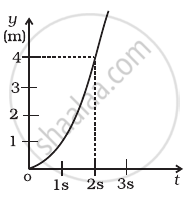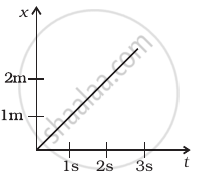Advertisements
Advertisements
प्रश्न
A metre scale is moving with uniform velocity. This implies ______.
पर्याय
the force acting on the scale is zero, but a torque about the centre of mass can act on the scale.
the force acting on the scale is zero and the torque acting about centre of mass of the scale is also zero.
the total force acting on it need not be zero but the torque on it is zero.
neither the force nor the torque need to be zero.
उत्तर
A metre scale is moving with uniform velocity. This implies the force acting on the scale is zero and the torque acting about centre of mass of the scale is also zero.
Explanation:
Since the body is moving with a uniform velocity, hence its acceleration is zero. This implies that the net force acting on it must be zero, which further makes the torque acting about the centre of mass of the scale also zero.
APPEARS IN
संबंधित प्रश्न
A body of mass 0.40 kg moving initially with a constant speed of 10 m s–1 to the north is subject to a constant force of 8.0 N directed towards the south for 30 s. Take the instant the force is applied to be t = 0, the position of the body at that time to be x = 0, and predict its position at t = –5 s, 25 s, 100 s.
If the tension in the cable supporting an elevator is equal to the weight of the elevator, the elevator may be
(a) going up with increasing speed
(b) going down with increasing speed
(c) going up with uniform speed
(d) going down with uniform speed
A person says that he measured the acceleration of a particle to be non-zero even though no force was acting on the particle.
A block is kept on the floor of an elevator at rest. The elevator starts descending with an acceleration of 12 m/s2. Find the displacement of the block during the first 0.2 s after the start. Take g = 10 m/s2.
State Newton's second law of motion. Under what condition does it take the form F = ma?
A pebble is thrown vertically upwards with a speed of 20 m s-1. How high will it be after 2 s? (Take g = 10 m s-2)
Define Newton’s second law of motion.
Multiple Choice Question. Select the correct option.
Which of the following are vector quantities?
Use Newton's second law to explain the following:
While catching a fast moving ball, we always pull our hands backwards.
Figure shows (x, t), (y, t ) diagram of a particle moving in 2-dimensions.
|
|
 (b) |
If the particle has a mass of 500 g, find the force (direction and magnitude) acting on the particle.

